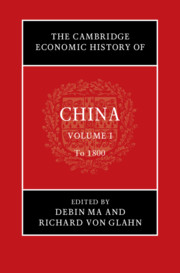Book contents
- The Cambridge Economic History of China
- The Cambridge Economic History of China
- The Cambridge Economic History of China
- Copyright page
- Contents
- Figures
- Maps
- Tables
- Contributors to Volume I
- Acknowledgments
- Note on Citations
- Introduction to Volume I
- Part I Before 1000
- 1 The Economy of Late Pre-imperial China
- 2 Agriculture and Its Environmental Impact
- 3 State and Economy
- 4 Money, Markets, and Merchants
- 5 Economic Philosophy and Political Economy
- 6 Silk Road Trade and Foreign Economic Influences
- Interlude
- Part II 1000 to 1800
- Bibliography of Primary Works Cited
- Index
- References
1 - The Economy of Late Pre-imperial China
Archaeological Perspectives
from Part I - Before 1000
Published online by Cambridge University Press: 07 February 2022
- The Cambridge Economic History of China
- The Cambridge Economic History of China
- The Cambridge Economic History of China
- Copyright page
- Contents
- Figures
- Maps
- Tables
- Contributors to Volume I
- Acknowledgments
- Note on Citations
- Introduction to Volume I
- Part I Before 1000
- 1 The Economy of Late Pre-imperial China
- 2 Agriculture and Its Environmental Impact
- 3 State and Economy
- 4 Money, Markets, and Merchants
- 5 Economic Philosophy and Political Economy
- 6 Silk Road Trade and Foreign Economic Influences
- Interlude
- Part II 1000 to 1800
- Bibliography of Primary Works Cited
- Index
- References
Summary
Continental East Asia during the first millennium bce transitioned from a redistributive “gift-giving economy” (or “prestige-good economy”) to a thriving market economy that was at least partly monetized. This transformation – gradual but all-encompassing and irreversible – led to a veritable “economic miracle” during the Warring States period (c. 450–221 bce), which brought unprecedented prosperity to large portions of the population. It will here be discussed through its reflections in the material record, spanning the eight centuries from c. 1000 bce down to approximately the time of the Qin unification in 221 bce.1 During this period, the Zhou kingdom and its constituent polities formed a relatively homogeneous culture area encompassing the middle and lower Yellow River basin and the middle Yangzi basin. Archaeological discoveries attest that, over time, many of the surrounding smaller and sociopolitically less complex regional cultures – defined by archaeologists on the basis of their material remains – were increasingly drawn into the Zhou orbit.
Keywords
- Type
- Chapter
- Information
- The Cambridge Economic History of China , pp. 15 - 51Publisher: Cambridge University PressPrint publication year: 2022



